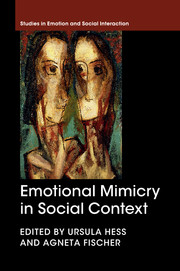Crossref Citations
This Book has been
cited by the following publications. This list is generated based on data provided by Crossref.
Hatfield, Elaine
Bensman, Lisamarie
Thornton, Paul D.
and
Rapson, Richard L.
2014.
New Perspectives on Emotional Contagion: A Review of Classic and Recent Research on Facial Mimicry and Contagion.
Interpersona: An International Journal on Personal Relationships,
Vol. 8,
Issue. 2,
p.
159.
2016.
Publications Received.
Contemporary Sociology: A Journal of Reviews,
Vol. 45,
Issue. 4,
p.
527.
2017.
Emotional Lives.
p.
168.
Brown, Andrew
2017.
Soundwalking: Deep Listening and Spatio-Temporal Montage.
Humanities,
Vol. 6,
Issue. 3,
p.
69.
Ask, Karl
2018.
Complainant emotional expressions and perceived credibility: Exploring the role of perceivers’ facial mimicry and empathy.
Legal and Criminological Psychology,
Vol. 23,
Issue. 2,
p.
252.
Clément, Fabrice
and
Dukes, Daniel
2019.
Foundations of Affective Social Learning.
p.
1.
Parkinson, Brian
2019.
Heart to Heart.
Vacaru, Stefania V.
van Schaik, Johanna E.
Hunnius, Sabine
and
Bos, Peter A.
2019.
The modulation of facial mimicry by attachment tendencies and their underlying affiliation motives in 3-year-olds: An EMG study.
PLOS ONE,
Vol. 14,
Issue. 7,
p.
e0218676.
Scherer, Klaus R.
Ellgring, Heiner
Dieckmann, Anja
Unfried, Matthias
and
Mortillaro, Marcello
2019.
Dynamic Facial Expression of Emotion and Observer Inference.
Frontiers in Psychology,
Vol. 10,
Issue. ,
Vacaru, Stefania V.
van Schaik, Johanna E.
de Water, Erik
Hunnius, Sabine
and
Bos, Peter A.
2020.
Five-year-olds’ facial mimicry following social ostracism is modulated by attachment security.
PLOS ONE,
Vol. 15,
Issue. 12,
p.
e0240680.
2020.
Beyond Virtue.
p.
251.
Mascolo, Michael
2020.
A Relational Conception of Emotional Development.
Emotion Review,
Vol. 12,
Issue. 4,
p.
212.
Israelashvili, Jacob
Sauter, Disa
and
Fischer, Agneta
2020.
Two facets of affective empathy: concern and distress have opposite relationships to emotion recognition.
Cognition and Emotion,
Vol. 34,
Issue. 6,
p.
1112.
Ziebell, Laura
Collin, Charles
Mazalu, Monica
Rainville, Stéphane
Weippert, Madyson
Skolov, Misha
and
Li, Zezhi
2020.
Electromyographic evidence of reduced emotion mimicry in individuals with a history of non-suicidal self-injury.
PLOS ONE,
Vol. 15,
Issue. 12,
p.
e0243860.
Salvadori, Eliala A.
Colonnesi, Cristina
Vonk, Heleen S.
Oort, Frans J.
and
Aktar, Evin
2021.
Infant Emotional Mimicry of Strangers: Associations with Parent Emotional Mimicry, Parent-Infant Mutual Attention, and Parent Dispositional Affective Empathy.
International Journal of Environmental Research and Public Health,
Vol. 18,
Issue. 2,
p.
654.
Tcherkassof, Anna
and
Dupré, Damien
2021.
The emotion–facial expression link: evidence from human and automatic expression recognition.
Psychological Research,
Vol. 85,
Issue. 8,
p.
2954.
Shah, Reena
and
Tewari, Ruchi
2021.
Mapping Emoji Usage Among Youth.
Journal of Creative Communications,
Vol. 16,
Issue. 1,
p.
113.
Genschow, Oliver
Westfal, Mareike
Cracco, Emiel
and
Crusius, Jan
2022.
Group membership does not modulate automatic imitation.
Psychological Research,
Vol. 86,
Issue. 3,
p.
780.
Kulesza, Wojciech
Chrobot, Nina
Dolinski, Dariusz
Muniak, Paweł
Bińkowska, Dominika
Grzyb, Tomasz
and
Genschow, Oliver
2022.
Imagining is Not Observing: The Role of Simulation Processes Within the Mimicry-Liking Expressway.
Journal of Nonverbal Behavior,
Vol. 46,
Issue. 3,
p.
233.
Kastendieck, Till
Zillmer, Stephan
and
Hess, Ursula
2022.
(Un)mask yourself! Effects of face masks on facial mimicry and emotion perception during the COVID-19 pandemic.
Cognition and Emotion,
Vol. 36,
Issue. 1,
p.
59.



